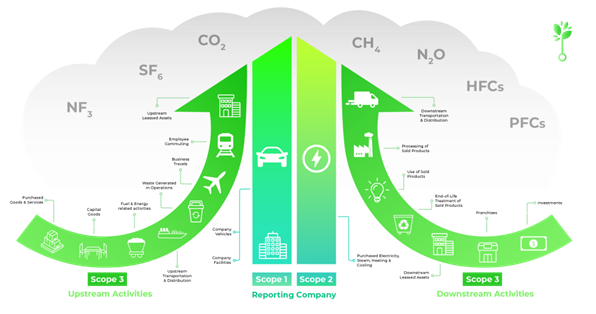Debunking climate myths: Planting trees is the main action we can take to solve climate change

The idea that planting trees alone can solve climate change is a myth, despite it being a valuable action. Relying on it as the sole solution oversimplifies the problem and ignores critical challenges.
The problem with planting trees as a primary solution
The main issue is the sheer scale of the problem. While trees are excellent at absorbing carbon dioxide (CO₂) through photosynthesis, the rate at which we’re emitting greenhouse gases – over 35 billion tonnes each year[1] – far outpaces the capacity of forests, which absorb around 16 billion tonnes annually[2], let alone what newly planted trees could take in. It takes a significant amount of time for a young tree to mature and become a truly effective carbon sink. An older, larger tree can sequester far more CO2 than a sapling.
The global context of the problem
Each year, the world loses around 10 million hectares of forest – an area roughly the size of Portugal. While new forests are being planted and some natural regeneration is taking place, these gains are not enough to offset the speed and scale of deforestation. The result is that forest loss still outweighs recovery[3].
Looking at the long arc of history, humans have been clearing forests for thousands of years. Since the end of the last Ice Age, we have lost about one-third of the planet’s forests, nearly two billion hectares in total. To put that in perspective, that’s an area twice the size of the United States. What is striking, however, is how quickly this trend has accelerated. Half of this total loss has occurred in just the past century.
Deforestation reached its global peak in the 1980s, when around 150 million hectares of forest were cleared in a single decade – about half the size of India. During earlier centuries, much of the clearing happened in temperate regions like Europe and North America, driven by population growth, agriculture, and demand for wood as fuel. But by the 20th century, the focus of deforestation had shifted to the tropics, where fertile land was opened up for crops, cattle, and timber.
Why, then, does deforestation still dominate over reforestation today? The main reason is that agriculture continues to expand. Forests are cleared to make way for large-scale farming and livestock, especially in tropical regions. In many countries, wood remains a vital source of fuel. And while some countries – particularly in temperate regions – have already passed through what scientists call the “forest transition” (a turning point where forest area begins to expand again), many tropical nations have not yet reached that stage. In these places, population growth and economic pressures still drive widespread clearing.
Even where forests are regrowing, the story is complicated. A significant share of “new” forests are actually plantations, which help absorb carbon but do not replace the biodiversity or ecological richness of natural forests. This means that from an environmental perspective, reforestation does not fully balance the losses.
In short, while parts of the world have begun to reverse centuries of forest loss, deforestation remains concentrated – and intense – in tropical regions, home to some of the richest biodiversity on Earth. Until global demand for land and resources eases, and reforestation efforts shift from plantations to natural ecosystems, the scale of forest loss will continue to outweigh the gains.
The space and time problem
Another significant challenge is the limited space for new forests. While there are still large areas of land available, much of it is already in use for farming, urban development, or is simply not suitable for forests. As the global population grows and urbanization increases, the amount of available land for large-scale reforestation shrinks annually. After excluding unsuitable areas, researchers estimated that around 0.9 billion hectares – roughly the size of the United States – could potentially be restored through reforestation[4].
Even if we had unlimited space, the time it takes for a newly planted forest to make a meaningful impact is a major factor. The climate crisis is an immediate threat. Scientists agree that we must drastically reduce emissions now, within the next decade, to avoid the most catastrophic effects of climate change. A newly planted tree will not be a major CO2 sink for many years, whereas a new car or a new power plant will start emitting CO2 from day one.
A broader, more effective approach
To truly combat climate change, we must take a multi-faceted approach. Planting trees is still a vital part of the solution, but it must be combined with more impactful strategies. The most effective actions are those that address the root causes of emissions:
- Drastically reducing the burning of fossil fuels: This is the single most important action. We must transition to renewable energy sources like solar and wind power[5].
- Improving energy efficiency: Making our homes, vehicles, and industries more energy-efficient will reduce the total amount of energy we need.
- Sustainable land management: Protecting existing forests, promoting agroforestry[6] (integrating trees with crops), and adopting more sustainable agricultural practices can reduce the need for further deforestation.
- Regenerative agriculture: This practice focuses on rebuilding soil organic matter and restoring degraded soil biodiversity, which can also help sequester carbon in the soil[7].
In conclusion, planting trees is a good and necessary action, but it’s not a silver bullet. It’s a supportive measure, not the main solution. The real work lies in fundamentally changing the way we produce and consume energy and manage our land.
—
[1] https://ourworldindata.org/co2-emissions
[2]https://www.nasa.gov/science-research/earth-science/nasa-satellites-help-quantify-forests-impacts-on-global-carbon-budget/#:~:text=According%20to%20the%20researchers%2C%20forests%20collectively%20absorbed,annual%20emissions%20from%20the%20entire%20United%20States.
[3] https://ourworldindata.org/deforestation
[4] https://newatlas.com/trees-reforestation-climate-change/60446/#:~:text=Under%20the%20current%20climate%20conditions%2C%20the%20team,using%20a%20substantial%20amount%20of%20that%20land.
[5] https://www.un.org/id/node/177543
[6] https://www.sciencedirect.com/science/article/pii/S0743016721000164
[7] https://link.springer.com/article/10.1007/s43621-024-00662-z
Other News

